Jews of Lithuania
*** *** ***
 The Vilna Gaon (April 23, 1720 – October 9, 1797) was a prominent Jewish rabbi, Talmud scholar, and Kabbalist. The Vilna Gaon (April 23, 1720 – October 9, 1797) was a prominent Jewish rabbi, Talmud scholar, and Kabbalist.
His real name was Elijah (Eliyahu) ben Shlomo Zalman "Kremer" (or "Kramer"), but he is commonly referred to in Hebrew as ha'Gaon ha'Chasid mi'Vilna, meaning "the saintly genius from Vilna", or in similar forms (Gaon of Vilna, Gaon mi Vilno, or Vilna Gaon), and as the Gra (a Hebrew acronym of "Gaon Rabbi Eliyahu"). While now commonly known - the Vilna Gaon.
Born in Vilna (now Vilnius), Lithuania, he displayed extraordinary talents while still a child. As young as three years old he had committed the Bible to memory. At the age of seven he was taught Talmud by Moses Margalit, rabbi of Kaidan and the author of a commentary to the Jerusalem Talmud, and was supposed to know several of the tractates by heart. The Vilna Gaon is well known for having possessed a photographic memory. By eight, he was studying astronomy during his lunch time. From the age of ten he continued his studies without the aid of a teacher, and by the age of eleven he had committed the entire Talmud to memory.
Vilna Gaon almost never took part in public affairs and, so far as is known, did not preside over any great school in Vilna. He was satisfied with lecturing in his bet ha-midrash to a few chosen pupils, whom he initiated into his scientific methods. He taught them Hebrew grammar, Hebrew Bible, and Mishna, subjects which were largely neglected by the Talmudists of that time. He was especially anxious to introduce them to the study of midrash literature, and the Minor Treatises of the Talmud, which were very little known by the scholars of his time.
The Vilna Gaon led an ascetic life. He interpreted literally the words of the ancient rabbis, that the Torah can be acquired only by abandoning all pleasures and by cheerfully accepting suffering; and as he lived up to this principle, he was revered by his countrymen as a saint, being called by some of his contemporaries "the Hasid".
The Gaon once started on a trip to the Land of Israel, but for unknown reasons did not get beyond Germany.
The Vilna Gaon was a voluminous author; there is hardly an ancient Hebrew book of any importance to which he did not write a commentary, or at least provide marginal glosses and notes, which were mostly dictated to his pupils. However, nothing of his was published in his lifetime.
There is a statue of the Vilna Gaon and a street named after him in Vilnius, the place of both his birth and his death.


*** *** ***
Berek Joselewicz was born in 1764 in Kretinga, Lithuania. He earned a living as a horse trader. Upon the outbreak of the Tadeusz Koúciuszko uprising in 1794, with the help of Józef Aronowicz he wrote an appeal in the Yiddish language calling the Polish Jews to arms. With around five hundred volunteers who responded to his call, he built a cavalry regiment. He persuaded Koúciuszko to allow that the Jewish freedom fighters observe their religious customs, including wearing beards, eating kosher meals and celebrating Sabbath whenever it's possible in the circumstances.
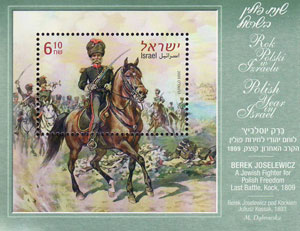

Berek Joselewicz's squadron was beaten during the battle to defend the Praga district of Warsaw, with only a few survivors remaining, including the captain. After the fall of the uprising, Berek Joselewicz emigrated to Italy, where he joined the Polish Legions of general Jan Henryk Dŕbrowski.
http://www.poczta-polska.pl/
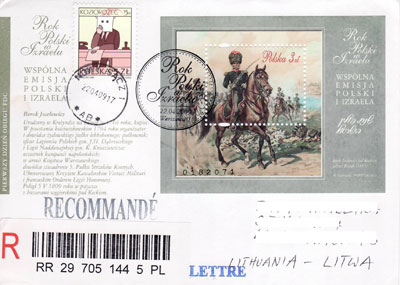
*** *** ***
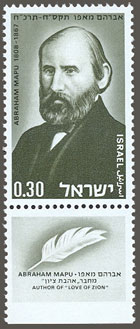 Abraham Mapu (1808 Kaunas – 1867 Koenigsberg) was a Lithuanian-born Hebrew novelist. Abraham Mapu (1808 Kaunas – 1867 Koenigsberg) was a Lithuanian-born Hebrew novelist.
He lived in Kaunas 1808–1837 and 1844–1867 except those years then he worked in other cities of Lithuania - Jurbarkas and Vilnius. For many years he was an impoverished, itinerant schoolmaster. Mapu gained financial security when he was appointed teacher in a government school for Jewish children. Mapu is considered the creator of the Hebrew novel. Influenced by French Romanticism, he wrote heavily plotted novels about life in Ancient Israel, which he contrasted favorably with 19th century Jewish life. His style is fresh and poetic, almost Biblical in its simple grandeur.
He began work on the historical novel Ahavat Zion in 1830, completing it only in 1853.


*** *** ***
Samuel Mohilever born 1824 in Hlubokaye ( now Belarus), died 1898 in Bialystok (Poland). He was famous jewish religion character. Mohilever was made the rabbi of Đakiai (Lithuania), Suwalki (1860-1868).
Michel Rundschau no. 2/2009 writes ““Samuel Mohilewer (1824-1898) litauischer Rabbiner”( Lithuanian rabbi).

*** *** ***
Jehuda Leon Gordon (1830-1892)

Jewish writer, born in Vilnius. Studied European cultures and languages as well as graduated from Jewish Teachers' Institute in Vilnius. Worked as a teacher in Panevezys, Siauliai, Telsiai. In 1872 moved to Petersburg, was improsoned and exiled to the north of Russia but exonerated afterwards. Edited Hebraic newspaper Ha-Meliz. Famous participant of Haskalah (Education) movement. Named as one of the greatests experts of the Hebrew language of all times.
*** *** ***
Yehuda Pen (1854-1937) a painter who was famous as the teacher of Mark Shagal. He was born in Zarasai, Lithuania in a poor family in 1854, June 5. Later on, he moved to Daugpilis (Dvinsk) and Vitebsk. He studied art in Art Academy in S. Petersburg. His life and activities were connected with Vitebsk Art School.
 


*** *** ***

Abraam Khvoles (1857-1931) - born in Lithuania and received eduction in the Slabodker (Kaunas) Yeshiva. At the end of 1890s A.Khvoles was elected chief rabbi of the town of Tzkhinvali (Georgia). He was sending students to the Lithuanian yeshivot to continue their education and receive the title of rabbi.
*** *** ***
 Isaak Levitan (1861-1900) was a classical russian landscape art painter who advanced the genre of the mood landscape. Isaak Levitan (1861-1900) was a classical russian landscape art painter who advanced the genre of the mood landscape.
Isaac Levitan was born in Kybartai, Kaunas region, Lithuania, into a poor but educated Jewish family. His father Elyashiv Levitan, was a son of a rabbi, completed a Yeshiva and in addition was self-educated. He taught German and French in Kaunas and later worked as a translator at a railway bridge construction for a French building company. In the beginning of 1870 the Levitan family moved to Moscow.
 
 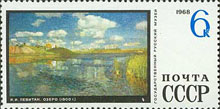
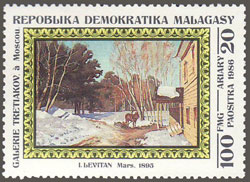

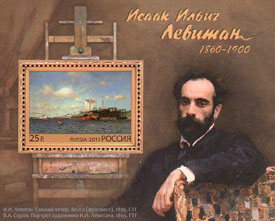

*** *** ***
Boris Schatz (1867 – 1932 ) was a Jewish artist and sculptor who founded the Bezalel School in Jerusalem.
Boris Schatz was born in Varniai, Kaunas district in 1867. His father, a teacher in a cheder (a religious school), sent him to study in a yeshiva in Vilnius, Lithuania. Left the yeshiva a short time later to study painting and sculpture in Vilnius (1882–1887) and Warsaw, Poland (1888–1889). In 1889, he moved to Paris to study at the Académie Cormon and noted artists there, among them Mark Antokolski whom he knew from Vilnius.

*** *** ***
 Joseph Klausner (1874-1958) Professor Joseph Gedaliah Klausner was a scholar. Born in Lithuania, he came to Palestine in 1919 where he was a professor of Hebrew literature and history at the Hebrew University. He published volumes of historical works. Klausner was a candidate for President in 1949. Joseph Klausner (1874-1958) Professor Joseph Gedaliah Klausner was a scholar. Born in Lithuania, he came to Palestine in 1919 where he was a professor of Hebrew literature and history at the Hebrew University. He published volumes of historical works. Klausner was a candidate for President in 1949.
*** *** ***
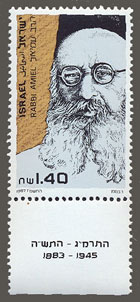 Rabbi Moshe Avigdor Amiel (1883-1946), a rabbi in Lithuania, then in Antwerp and finally, from 1937 until his death, chief Rabbi of Tel Aviv. Born in Lithuania, Moshe Avigdor Amiel was first taught by his father at the Telz (now Telsiai,Lithuania) yeshiva before proceeding to the Vilnius yeshiva to study under the two greatest Talmudic scholars of the time - Rabbi Chaim Soloveichik and Rabbi Chaim Ozer Grodzinsky. He received his ordination at the age of eighteen and in 1905 was appointed Rabbi of Swieciany(Svencionys, Lithuania) where he founded a large yeshiva. Rabbi Moshe Avigdor Amiel (1883-1946), a rabbi in Lithuania, then in Antwerp and finally, from 1937 until his death, chief Rabbi of Tel Aviv. Born in Lithuania, Moshe Avigdor Amiel was first taught by his father at the Telz (now Telsiai,Lithuania) yeshiva before proceeding to the Vilnius yeshiva to study under the two greatest Talmudic scholars of the time - Rabbi Chaim Soloveichik and Rabbi Chaim Ozer Grodzinsky. He received his ordination at the age of eighteen and in 1905 was appointed Rabbi of Swieciany(Svencionys, Lithuania) where he founded a large yeshiva.
http://www.mizrachi.org/elearning/View_history.asp?id=137

*** *** ***
 Bernard Revel (1885-1940) was born in Kaunas, Lithuania, in 1885. He studied at the yeshivah of Telđiai. In 1906 he emigrated to the U.S., where he studied at New York University and Dropsie College in Philadelphia. In 1915, recognized as the religious authority of the Isaac Elchanan Theological Seminary in New York, Revel revolutionized Orthodox learning in the United States. He opened the yeshivah to laymen and teachers as well as rabbinical students. In 1916 he founded the Talmudical Academy, the first combined academic high school-yeshivah in the U.S. In 1928 Revel went even further. Despite strong opposition from those who feared that Torah study would be undermined, he founded Yeshiva College as an extension of the seminary. Bernard Revel (1885-1940) was born in Kaunas, Lithuania, in 1885. He studied at the yeshivah of Telđiai. In 1906 he emigrated to the U.S., where he studied at New York University and Dropsie College in Philadelphia. In 1915, recognized as the religious authority of the Isaac Elchanan Theological Seminary in New York, Revel revolutionized Orthodox learning in the United States. He opened the yeshivah to laymen and teachers as well as rabbinical students. In 1916 he founded the Talmudical Academy, the first combined academic high school-yeshivah in the U.S. In 1928 Revel went even further. Despite strong opposition from those who feared that Torah study would be undermined, he founded Yeshiva College as an extension of the seminary.

It was the first liberal arts college under Jewish auspices. It represented the first attempt to offer a traditional Talmudic education with a modern course of secular studies. Revel, who served as president of the college, organized the graduate school of Jewish studies, named after him, in 1937. He was the first institutional head to give semichah to Orthodox rabbis in the U.S. Revel was honorary president of the Union of Orthodox Rabbis of the United States and Canada, and was vice-president of the Jewish Academy of Arts and Sciences from 1927 until his death in 1940.
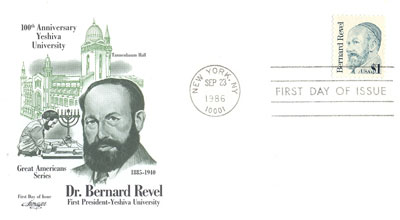
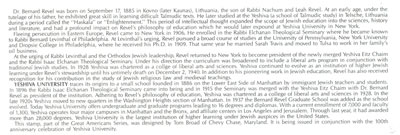
*** *** ***
Al Jolson (1886-1950) - born as Asa Yoelson in Seredzius, Lithuania on May 26, 1886. Was American singer and te son of Jewish emmigrants. He was one of the most popular entertainers of the 20th century. The key lements of his performance was blackface make-up, exuberat gestures, operatic style singing, whistling and directly addressing his audience.
Best known today, for his appearance in one of the first "talkies" The Jazz Singer, the first feature film with sound to enjoy wide commercial succes,in 1927.
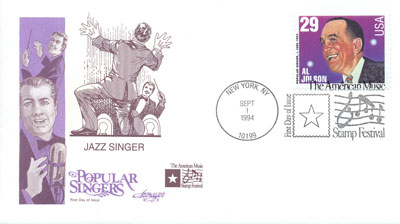

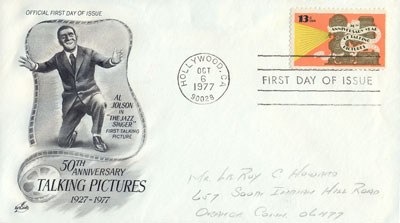


*** *** ***
 Chaim Soutine (1893 -1943) was a Jewish expressionist painter. Chaim Soutine (1893 -1943) was a Jewish expressionist painter.
Born in Smilavichi (now in Belarus). 1910-1913 he been studying in Vilnius at Ivan Trutnev painting school. Emigrated to Paris in 1913 with his friends where he studied at the Ecole des Beaux-Arts. He soon developed a highly personal vision and painting technique.
For a time, he and his friends lived at La Ruche, a residence for struggling artists in Montparnasse. In 1923, the American collector Albert C. Barnes visited his studio and immediately bought sixty of Soutine's paintings. Soutine went on to produce landscapes, still-lifes, and portraits.
Chaim Soutine once horrified his neighbours by keeping an animal carcass in his studio so that he could paint (Carcass of Beef). The stench drove them to send for the police, whom Soutine promptly lectured on the relative importance of art over hygiene. On Tuesday the 7th of February 2006 this painting sold for Ł7.8m to an anonymous buyer in London.
Soutine was interred in Cimeti?re du Montparnasse, Paris, France. After his death his vivid colors and passionate handling of paint gained him recognition as one of the foremost Expressionist painters.


*** *** ***
 Abba Hillel Silver (1893-1963) was a U.S. Rabbi and Zionist leader. Born in Lithuanian town Kudirkos Naumiestis ( in that time Neustadt-Schirwindt), he was taken to the U.S. as a child. He was the rabbi of The Temple in Cleveland, Ohio, and also served as head of many Jewish and Zionist organizations. Silver was one of the chief Zionist spokesmen before the United Nations in the Palestine hearings of 1947. Abba Hillel Silver (1893-1963) was a U.S. Rabbi and Zionist leader. Born in Lithuanian town Kudirkos Naumiestis ( in that time Neustadt-Schirwindt), he was taken to the U.S. as a child. He was the rabbi of The Temple in Cleveland, Ohio, and also served as head of many Jewish and Zionist organizations. Silver was one of the chief Zionist spokesmen before the United Nations in the Palestine hearings of 1947.
More info about A.H.Silver:
http://www.clevelandjewishhistory.net/silver/index.htm
*** *** ***
 Lasar Segall (1897-1957) was a Brazilian painter of Lithuanian Jewish origin.
Segall was born in Vilnius, but moved to Berlin at the age of 15 and studied at the Royal Prussian College of Fine Arts. Frustrated with the academic school of painting in vogue there, he left for Dresden in 1910 and began developing his own style, which incorporated aspects of Cubism while exploring Segall's Jewish background. Lasar Segall (1897-1957) was a Brazilian painter of Lithuanian Jewish origin.
Segall was born in Vilnius, but moved to Berlin at the age of 15 and studied at the Royal Prussian College of Fine Arts. Frustrated with the academic school of painting in vogue there, he left for Dresden in 1910 and began developing his own style, which incorporated aspects of Cubism while exploring Segall's Jewish background.
Vilnius made deep sign in his creation. In 1921-1922 he made etchinged folder in memory of Vilnius city.

*** *** ***
 Ben Shahn (1898-1969) The painter, muralist and printmaker, Ben Shahn, was born in 1898 in Kaunas, Lithuania, into a family of Jewish craftsmen; he moved with his family to New York City in 1906. In 1913-17 Shahn was a lithographer's apprentice while attending high school at night. He later attended New York University, the College of the City of New York, and the National Academy of Design in New York. Shahn's first major work (1931-32) was a series of paintings of the trial of the anarchists Sacco and Vanzetti. Shahn expressed his sympathy for the defendants with great emotional power and satiric bite. That series, which brought him fame, was followed in 1932-33 by another famous trial, this one of the labour leader Tom Mooney. Later he made another famous series about the Lucky Dragon, a Japanese fishing boat that wandered into a nuclear test zone. A 150-stamp set, Celebrate the Century, was the US Postal Service's attempt to reflect 20th century American history in philately. One of the stamps in this series, Prohibition Enforced, depicts a detail from the Ben Shahn painting, now in the Museum of the City of New York, showing federal agents disposing of wine. Ben Shahn died on March 14, 1969, in New York City. Ben Shahn (1898-1969) The painter, muralist and printmaker, Ben Shahn, was born in 1898 in Kaunas, Lithuania, into a family of Jewish craftsmen; he moved with his family to New York City in 1906. In 1913-17 Shahn was a lithographer's apprentice while attending high school at night. He later attended New York University, the College of the City of New York, and the National Academy of Design in New York. Shahn's first major work (1931-32) was a series of paintings of the trial of the anarchists Sacco and Vanzetti. Shahn expressed his sympathy for the defendants with great emotional power and satiric bite. That series, which brought him fame, was followed in 1932-33 by another famous trial, this one of the labour leader Tom Mooney. Later he made another famous series about the Lucky Dragon, a Japanese fishing boat that wandered into a nuclear test zone. A 150-stamp set, Celebrate the Century, was the US Postal Service's attempt to reflect 20th century American history in philately. One of the stamps in this series, Prohibition Enforced, depicts a detail from the Ben Shahn painting, now in the Museum of the City of New York, showing federal agents disposing of wine. Ben Shahn died on March 14, 1969, in New York City.
*** *** ***
 Lea Goldberg (1911-1970). Born in Kaunas, Lithuania. Her family after the 1917 Revolution returned to their home in Kovno (now Kaunas), Lithuania. She began to publish Hebrew verse while still a schoolgirl. Goldberg attended the University of Kaunas. Lea Goldberg (1911-1970). Born in Kaunas, Lithuania. Her family after the 1917 Revolution returned to their home in Kovno (now Kaunas), Lithuania. She began to publish Hebrew verse while still a schoolgirl. Goldberg attended the University of Kaunas.
Leah Goldberg studied at Lithuanian and German universities, receiving her Ph.D. in 1933. She made aliyah in 1935 where she worked as a literary adviser to Habimah theater and as an editor for Sifriyat Poalim books. She became a lecturer in literature at the Hebrew University in 1954.
Her poems are known for their melancholy subjects with positive messages. Her themes include wounded love as well as a yearning for love and light. Her work is marked by an aesthetic intellectualism bordering on modernism. In addition to her poems, she wrote poems for children, a novel, a play and was responsible for translating a number of Russian and French masters into Hebrew.
She listed two contradictory birth places: in a 1956 biographical manuscript she wrote that she was born in Königsberg, but when filling out a form for the Israeli authors' association in 1964 she listed her birth place as Kaunas.
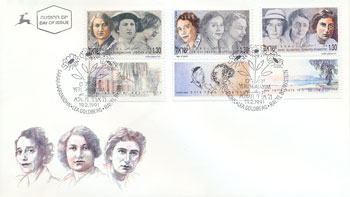

*** *** ***
Yosef Glazman (1913-1943) and Vilna Ghetto

The Vilna Ghetto was a Jewish ghetto in Vilnius, now in Lithuania. Vilna was then the most common English name for the city. Nazis troops entered the city on June 24, 1941. Over the course of the summer, troops killed more than 35,000 Jews living in Vilnius in a rapid extermination program. On September 6 and 7, 1941, the Nazis herded the remaining 38,000 Jews into the parameters of two ghettos.
The United Partisan Organization-Fareinikte Partisaner Organizatzie - F.P.O.- was formed on January 21, 1942 in the Vilna Ghetto. It took on the motto: "We will not allow them to take us like beasts to the slaughter." This was one of the first resistance organizations that was established in the ghettos during World War II. Unlike in other ghettos, the resistance movement in the Vilna Ghetto was not run by ghetto officials.
It was headed by Yitzhak Wittenberg, Josef Glazman, and Abba Kovner. The goals of the FPO were to establish self-defense in the ghetto, to sabotage German industrial and military activities and to join the partisan and Red Army's fight against the Nazis.
The Vilna Ghetto was called "Yerushalayim of the Ghettos" because it was known for its intellectual and cultural spirit. Before the war, Vilnius had been known as "Yerushalayim d'Lita" (Yiddish: Jerusalem of Lithuania) for the same reason
On right stamp in s/s - Josef Glazman. He was born in Alytus, Lithuania. Then soviets took over Lithuania he moved to Vilnius. Before that he was editor for magazine "Ha Medina".
*** *** ***
 Yitzhak Zuckerman "Antek" (1915-1983) - leader of the ghetto fighters - came to symbolize the Jews' fight for freedom. Born in Vilna (Vilnius, Lithuania) in the year 1915, Antek was educated at the local Jewish schools and he planned to continue his education at the Hebrew University of Jerusalem. However he became deeply involved in the Jewish pioneer youth movements and became one of the leaders of Hechalutz which later merged with Freiheit to form Dror. It did not take long before he was called upon to work in the areas occupied by the Nazis and in 1940 he arrived in Warsaw and took over the leadership of the Pioneer Youth in the Ghetto. From the moment that he realized that the Nazis planned to exterminate European Jewry, he devoted all his efforts to building up a Jewish fighting force and it was he who was responsible for planning the Jewish resistance to the Nazi conquerors in the Warsaw, Vilnius and other ghettos. Yitzhak Zuckerman "Antek" (1915-1983) - leader of the ghetto fighters - came to symbolize the Jews' fight for freedom. Born in Vilna (Vilnius, Lithuania) in the year 1915, Antek was educated at the local Jewish schools and he planned to continue his education at the Hebrew University of Jerusalem. However he became deeply involved in the Jewish pioneer youth movements and became one of the leaders of Hechalutz which later merged with Freiheit to form Dror. It did not take long before he was called upon to work in the areas occupied by the Nazis and in 1940 he arrived in Warsaw and took over the leadership of the Pioneer Youth in the Ghetto. From the moment that he realized that the Nazis planned to exterminate European Jewry, he devoted all his efforts to building up a Jewish fighting force and it was he who was responsible for planning the Jewish resistance to the Nazi conquerors in the Warsaw, Vilnius and other ghettos.
Zivia Lubetkin was his wife.
*** *** ***
JOSE GURVICH /Zusmanus Gurvicius/ (1927-1974)
1927 January 5th. He was born in the midst of a snow storm, in the village of Yezna (Jieznas), district of Trakai, in Lithuania. His parents, Jacobo Gurvich and Jaie Galperas, lived humbly in this small village.
Gurvich's memories of his country of origin are vague, but he recalls them in his writings and they appear in his pictures.
http://www.museogurvich.org
http://www.ceciliadetorres.com/jg/jg_bio.html
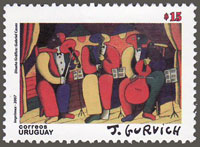

|